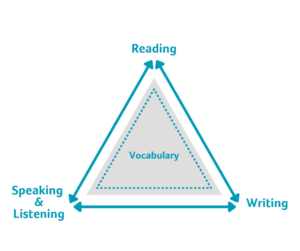We use all types of data in education. It drives everything we do. We use achievement data, demographic data, program data, perception data – just to name a few. But what about lesson design data? How might we use data to proactively design instruction that intentionally supports how students learn? How DO students learn? Well, literacy is the answer to that question. Literacy is how we all learn. Therefore, we should be very intentional in designing instruction that ensures we are attending to the learning needs of our students.
First, we must define what literacy is. Many well-respected organizations in the field of literacy define it differently, but for our purposes, we will define literacy as the ability to read, write, speak and listen about a particular topic (or content area, or unit of study). Furthermore, attending to vocabulary is critical and supports each of those three areas – it improves ability to comprehend text, write knowledgeably, and engage in fruitful academic conversation (see the Literacy Triangle below). So, how might one design instruction that brings this idea of literacy into balance? Note that this triangle is not a scalene or isosceles triangle, but an equilateral triangle, with equal sides – that illustrates balance.
 It’s important to first begin by identifying where you currently are. To do this, begin by having teachers reflect on where their current instructional practices are through a literacy-focused lens. This Teacher Survey Tool unpacks the components of the Literacy Triangle, left, specifically attending to reading (i.e, “I plan before-, during-, and after- reading activities to support my students’ comprehension of content text.”), writing (i.e., “I expect students to use content vocabulary in their writing.”), speaking and listening (i.e., “When I plan, I include opportunities for structured student-to-student dialogue.”), and vocabulary (i.e., “I expect students to use content vocabulary when they speak.”). Once teachers complete the teacher survey, you can begin to identify areas of strength and opportunities for growth.
It’s important to first begin by identifying where you currently are. To do this, begin by having teachers reflect on where their current instructional practices are through a literacy-focused lens. This Teacher Survey Tool unpacks the components of the Literacy Triangle, left, specifically attending to reading (i.e, “I plan before-, during-, and after- reading activities to support my students’ comprehension of content text.”), writing (i.e., “I expect students to use content vocabulary in their writing.”), speaking and listening (i.e., “When I plan, I include opportunities for structured student-to-student dialogue.”), and vocabulary (i.e., “I expect students to use content vocabulary when they speak.”). Once teachers complete the teacher survey, you can begin to identify areas of strength and opportunities for growth.
The Student Survey Tool, on the other hand, can be used to provide insight into students’ perspective on their daily learning experiences. This tool aligns with the literacy indicators on the Teacher Survey Tool but in student-friendly language. One indicator reads, “In class, I have the chance to read a variety of materials about what we are learning,” which correlates with the reading point on the Literacy Triangle, while “In this class, I have opportunities to write about what I do and do not understand” targets the writing component. Furthermore, indicators such as “I have the chance to discuss what I’m learning with other students during class” help students recognize opportunities for speaking and listening in their classroom. Note: It is important that these survey tools be administered in a variety of settings, as students are reflecting on the learning experiences in that particular class. Literacy doesn’t just happen in English Language Arts classes – these indicators should be present in all content areas including mathematics, science, foreign language, even physical education. Remember, literacy is how we learn, whether it be about the Periodic Table of Elements or the causes of the Revolutionary War.
In addition to the Teacher and Student Survey Tools, the Classroom Literacy Tool can be used in a few different ways and serve as another source of data. It can be used by teachers, instructional coaches, and administrators to gauge to take a temperature check on how well teachers implement core strategies and processes to support ongoing literacy skill development for students, support student learning and activity, and provide a literate environment and physical space in the classroom. This tool is not meant for individual teacher observations or feedback, but rather for content area, grade level, and school level data that identify patterns regarding literacy-based instructional practices. Several indicators on the Classroom Literacy Tool directly correlate with indicators on the Teacher and Student Surveys so that you can compare apples to apples.
Engaging in professional conversation and working to define what each indicator means on the Classroom Literacy Tool is critical to ensuring quality, useful, calibrated data. The Classroom Look-Fors that follow the tool can be helpful during these conversations and even for teachers during planning.
It is recommended that data be collected and calibrated at least once each year, however it is ideal for data to be collected at multiple points throughout the year (beginning, middle, and end). In Using Instructional Design Data to Improve Instructional Practice, Part 2, I will introduce some research-based planning tools that you can use to address the data you have collected and, as the title suggests, improve your instructional practice.
